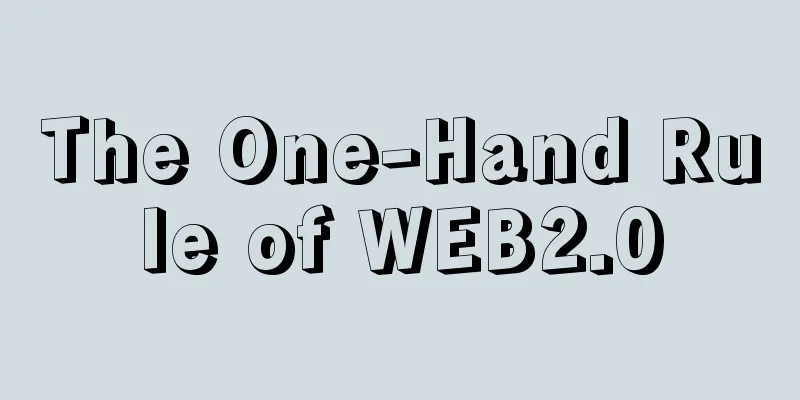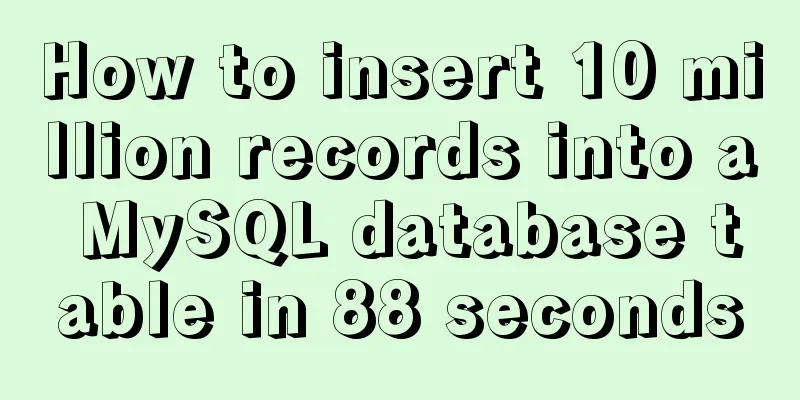The One-Hand Rule of WEB2.0

|
<br />My previous article about CSS was not well understood by many people. As a result, I have been thinking about how to write an article about CSS for a long time, but I have not yet come up with a satisfactory answer. It's a new year, and I look back on the past days. I've been busy with a lot of things in the company and haven't written any technical articles for almost a month. I also haven't paid attention to things in the group for a long time (I've blocked several people). I went back to the group these two days and found that the quality has declined; there are more and more people chatting, and more and more people talking about random things. ...It seems like it's time to write something to boost the morale of the website reconstruction staff and set a clear goal for everyone. Back to the topic, about WEB2.0. Everyone should be familiar with this term. The Chinese Internet has been abuzz in recent years. Some people praise it, while others think it is hype. However, do these people know WEB2.0? That’s right, my target is not only the CEOs of various Internet companies, but also those bloggers who want to become famous by writing a comment. Or maybe you think I am such a person, then let's take a look at what we know about WEB2.0: WEB2.0 is a concept that is not technology-oriented; WEB2.0 is a general term represented by a series of websites; WEB2.0 uses users as the source of content; WEB2.0 was conceived in March 2004 by Dale Dougherty, vice president of online publishing and research at O'Reilly Media Inc. What I want to talk about here are the people and companies who proposed this. Dale Dougherty was one of the first people to come up with the API. For such a technical person to come up with a concept that is not technology-driven is enough to determine that this is an unbelievable scam. I remember EMU saying, "A technical person with technical influence will lose his influence once the work he does loses its technical influence. Without influence, he will lose confidence in any work he does, and it will become ineffective." On the other hand, a series of websites are collectively represented. So, are those websites based on their models and structures called websites of the WEB2.0 era? That’s why there are so many “WEB2.0 that are looking for death”. Because it is impossible to reach the so-called end point by developing in multiple directions from one end point description. The third point is that many so-called content is king, and further, users are used as the source of content. So where do our users come from? Does it mean that except for domestic companies like Tencent, Taobao, etc. which have large user groups, other companies cannot enter WEB2.0? As you can see, in the speech article "What is WEB2.0" (official translation) compiled by Tim O'Reilly, the points that the Chinese people paid attention to after conveying it are full of loopholes. Just like the book "Website Reconstruction" that everyone in the web page industry knows, it became DIV CSS in China. But I don't know if you have read this book carefully, there is a sentence in it by Jeffrey Zeldman - "That is, there is no fixed standard or reason to use div tags as structural elements, but in fact this is a more advanced abuse of tables." The original text is "Well, if you know anything about templates, you will know that you can use tables or <div> tags. Well, it's the same for nested templates. In other words, if you wanted to yank out the tables and replace them with <div> tags, you still can use nested templates and it will still work. There is no rule or technical reason that says you can't use <div> tags in templates or nested templates or library items." (Source from the Internet). Therefore, what really hinders our development are not the books we "borrow" from others, but the ducks being pinched by invisible hands as described by Lu Xun. However, this article is not just about pointing out the problem without solving it like many people do. That is, I want everyone to know the one-handed principle of WEB2.0. According to the second half of Tim O'Reilly's speech and Dale Dougherty's intention, we can summarize the technology mergers mentioned in the middle into the following five points in the order of their appearance in history (such as RSS and XML merged into XHML, etc.):
We will name the above 5 technical points according to the order of our fingers:  Let's all put one of our hands up, and follow me to do an experiment just like you learned the "right-hand rule" and "left-hand rule" in physics class: (of course, the premise is that you are a normal human being) bend any one finger close to the palm, and see if the other four fingers can still be in a straight line with the back of the hand and are comfortable. Have you noticed something strange: when a single finger is bent, only the thumb [API] can complete the specified action. Let's see what this means: When individual technologies are combined for implementation, only the API alone can accomplish the task. However, in our opinion, if we only build APIs, there should only be our users on the Internet, because these users will only continue to open source their own "interfaces" (let's not talk about technical APIs here), and continuously output the data and information we want. At the same time, our WEB2.0 can survive by relying solely on this point, which is what we often see VCs investing money in. In this WEB2.0 era, it is already difficult for a product to emerge; it is even more difficult to survive. Moreover, if you are struggling in a survival stage in an endless protracted war without knowing how to use these technical techniques to maintain your livelihood and increase revenue and reduce expenditure, it is tantamount to seeking your own death. Let's take examples one by one. For example, the tail finger [SEO] is the common spam site. There is no technical skill to make a static page. After being banned by mobile, many spam site webmasters have been forced to transform into server providers. Next is the ring finger [AJAX]. Here I would like to take Fanfou as an example. I once bet with someone in the group that they could not sustain for more than two years unless they transformed. The reason for not being optimistic about it is that it uses too many server operations, and it is impossible to make the page static and the data static; there will be too much traffic consumption and performance consumption of the server spitting out pages. Speaking of the middle finger [CSS], what was the corresponding form of WEB1.0 in the past? To develop a new terminal platform for a business, it was necessary to recruit a new development team; but in the era of WEB2.0, we only need to use a development team and an excellent page reconstruction personnel, and connect the media attributes of the CSS connection in the page to "screen", "handheld", "TV" and so on to show different performances, thereby achieving cost reduction and opening up new sources of revenue. It can be seen from this that in WEB2.0, to be truly invincible, you must bend all five fingers together, that is, grasp all five technologies together. Many people may wonder, SEO and AJAX are conflicting technologies in themselves; so how can they coexist in the technical field of WEB2.0? Let’s look at our hands. The ring finger [AJAX] and the little finger [SEO] are close and connected. In our product form, this state only appears on our "Portal side" and "client side". We should implement AJAX for the client side that is visited the most by users (for the entire site), staticize the templates, and dynamically pull data. At the same time, we can also use AJAX's ability to not be indexed by search engines to protect users' unpublished, encrypted, and peer-to-peer information and content. On the other hand, we should staticize the page files on the portal side, so that the information that users want to publish can be more easily indexed by search engines, increasing the popularity of the website and users and consolidating information. (Here we are talking about the information itself, not the users themselves as done by many so-called WEB2.0 websites. Of course, there are some technical details and techniques here.) On the other hand, we use complete XHMTL (including semantic page files and RSS) to express the page structure, and use multi-directional CSS as a low-cost extension for multi-platform terminals. Finally, use multi-support plug-ins and standardized APIs (here we are referring to the technical API) to encroach on those Internet territories that do not belong to you. For example, Fanfou's plug-ins (11 blog service providers) and Jiwai's input channels (9 kinds) and API are very successful in my opinion. In comparison, other big brothers now seem to be "living off their old capital", such as blogcn, which has lost its position as a "moving tool", Taotao, which has lost its position as an input channel... and so on. I have had this rule for almost a year. I have always been following the method of look at 3, do 2 and say 1, but it has been almost a year since I looked at and did this 3; I have only said it out now because I have not yet seen a higher 3 in my heart. But I believe in "willing to give up" - if you give up, you will gain. Just as I was going through such a stage without 3 before I figured these things out. But the current situation is that it is really necessary to write him out. You can also see that the five technologies mentioned here are all within the scope of responsibility of our website reconstruction personnel (referring to website reconstruction rather than page reconstruction and page production), so we should have the responsibility and obligation to do a good job in China's WEB2.0. Although we are only at the technical level, the real WEB2.0 certainly has other aspects to grasp. However, some of the implementation details and techniques in this rule cannot be disclosed due to commercial confidentiality principles. I hope you will forgive me. |
<<: Using CSS to implement image frame animation and curve motion
>>: Vue implements image drag and drop function
Recommend
jQuery implements HTML element hiding and display
Let's imitate Taobao's function of displa...
jQuery implements a simple carousel effect
Hello everyone, today I will share with you the i...
Create a virtual environment using venv in python3 in Ubuntu
1. Virtual environment follows the project, creat...
Installation and configuration of mysql 8.0.15 under Centos7
This article shares with you the installation and...
Linux kernel device driver Linux kernel basic notes summary
1. Linux kernel driver module mechanism Static lo...
How to optimize images to improve website performance
Table of contents Overview What is Image Compress...
Solution to 404 Problem of Tomcat Installation in Docker
Find the containerID of tomcat and enter the toma...
Detailed explanation of Windows time server configuration method
Recently, I found that the company's server t...
How to build a drag and drop plugin using vue custom directives
We all know the drag-and-drop feature of HTML5, w...
Bootstrap 3.0 study notes buttons and drop-down menus
The previous article was a simple review of the B...
Tutorial on configuring SSH and Xshell to connect to the server in Linux (with pictures)
>>>>>Ubuntu installation and confi...
Detailed description of shallow copy and deep copy in js
Table of contents 1. js memory 2. Assignment 3. S...
Compatibility with the inline-block property
<br />A year ago, there were no articles abo...
5 JavaScript Ways to Flatten Arrays
Table of contents 1. Concept of array flattening ...
Troubleshooting ideas and solutions for high CPU usage in Linux systems
Preface As Linux operation and maintenance engine...









